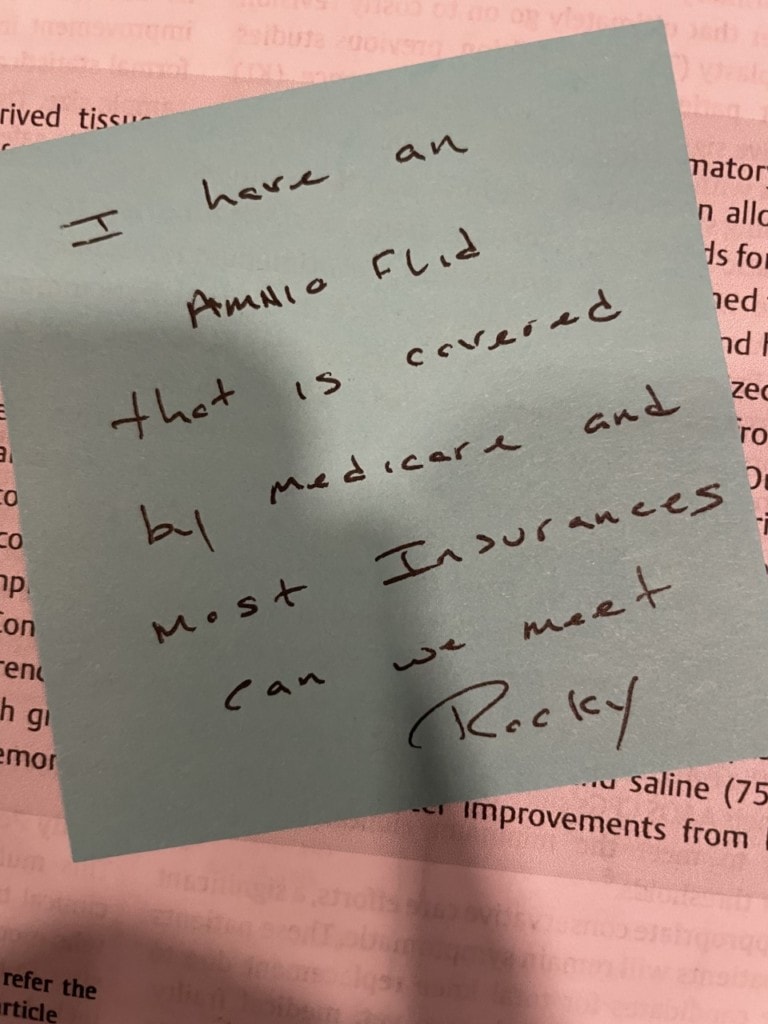Target the Drug Dealers…

Credit: Shutterstock
One of the more interesting phenomena in the Stem Cell Wild West that few have focused on is the role of sales reps in helping birth tissue companies who violate FDA regulations day in and day out. While the FDA has said that it wants to target the manufacturers, one of the Big Kahuna targets for the agency should be sales reps. Let’s dig in.
What Is a Sales Rep?
In this context, orthopedic sales reps are the people who take a product from a manufacturer and then sell it to doctors. Through the years, they establish relationships with certain types of physicians, and then when they get a new product they utilize those relationships to sell that device, drug, or tissue to those doctors. Before I launch into this blog, it’s key to know that for every bad sales rep I have seen, there are 4-5 hard-working and honest reps trying to do what’s right. Sure they’re getting paid to sell something, but they also realize that the long-term relationships that they want to build over a career can’t be tainted by selling a doctor something that isn’t accurate or true.
The Role of Orthopedic Sales Reps in Building the Stem Cell Wild West
If the manufacturers of birth tissue products have been like the cartels who manufacture meth and cocaine and ship it north, the sales reps are like the drug dealers. They’re the ones that connect the manufacturer to the physician end-users. So when the FDA announced that it would be going after manufacturers who violated the law by claiming that they were selling amniotic and umbilical cord “stem cell” products (that don’t actually contain any stem cells), they left out a major player in the food chain of how clinics are able to scam patients. To learn more about this whole birth tissue “stem cell” phenomenon, see my video below:
The Manufacturers vs. Sales Reps Since the FDA Crackdown
The FDA initiated a major crackdown on May 31st of this year and made it crystal clear that claiming that you were selling an amniotic product that you claimed had stem cells or that could be used to treat orthopedic problems was not OK. In response, many of the manufacturers cleaned up their websites. Some even dropped products from the market. However, in some cases, the violative behavior just switched from the manufacturers to the sales reps. Let me give you two examples just from this week.
Emerging Medical Group
This is a sales rep that sent an e-mail to a colleague this week. I went to their website and one of the red flags for me is that there was no information about who is behind the curtain. Meaning no names are listed of people that work there. Not even Linkedin knows who is employed or owns this company. I also called Emerging Medical Group and had to leave a message. I even called the sales rep that sent the email, Dana Vian, multiple times with no response. This is what was in the email:
“Finally, you will be able to treat patients and be reimbursed with an FDA approved designated product for joints, fascia, tendons, neuropathy, skin conditions, and more. This product is placental based extra cellular matrix, lyophilized with a 10 year shelf life. We have both Medicare reimbursable and cash options. It has received FDA RFD approval (Request For Designation – a binding FDA decision as to the compliance and category of a product) as an injection for the replacement or supplementation of damaged or inadequate integumental tissue and a CMS code for the same definition/use.”
Let’s deconstruct this paragraph. First, there is no FDA-approved placental birth tissue right now. FDA approval means that the product has gone through the clinical trials gauntlet and passed. There is certainly no FDA-approved placental tissue that is authorized to treat: “joints, fascia, tendons, neuropathy, skin conditions, and more.” Hence, IMHO, this is all misinformation.
Next up is this concept of an RFD (Request For Designation). Dana and Emerging Medical claim that they have received this vaunted “RFD approval”! I called an actual regulatory attorney and he laughed. This is actually a request to determine which department of the FDA (CBER, CDRH, CDER, etc…) an application for something should be sent to. There is no “approval” as it’s just a routing step. It also has nothing to do with CMS or a billing code. So again, IMHO, more misinformation.
Rocky Mountain Medical Distributors
Next up is a rep called Rocky Lobdell. He left this for another colleague this week:

This was left with his card and a paper that is one of the few to date showing short-term relief of knee arthritis after injecting a birth tissue product, but this study didn’t use the product he was selling. I called Rocky and asked which product he was hawking and was told that it was BioLabs FluidFlow, which is an amniotic product. He claimed on the phone that there were so many Medicare-covered clinical indications for his product that he couldn’t list them all-joints, muscles, tendons, etc… He stated that he could set me up with a billing company that would teach my office how to bill as well as a reimbursement guarantee (meaning that they would reimburse me with product if I didn’t get paid as advertised).
Is any of that true? Is there actual Medicare reimbursement for the use of amniotic or placental tissue injections to treat knee arthritis? Nope. See my video below for more information:
Peter Marks, the head of FDA CBER also made clear that any codes that were issued at some point by CMS were in error and are in the process of being canceled. This is from a Q and A conference session earlier this year:
Here is the panelist question as read by Dr. Marks: “Companies claiming that their amniotic products have an approved Q-code to be reimbursable to treat orthopedic conditions.”
Peter Marks Answer: “We are currently in the process of rectifying that. We’ve met with CMS and it turns out that it’s not trivial to get rectified but it is an issue and these should not have a Q-code for orthopedic conditions, because it’s not consistent, it can only be used consistent with the way we would use amniotic tissues which is as a covering.”
Later after someone else brings this same topic up…
“This Q-code issue is something that I apologize for….let’s be transparent. This is what happens in big bureaucracies in government. You have CMS over here and FDA over here, the companies apply to CMS, CMS doesn’t talk To FDA and so some of this Q-code stuff has occurred. We’re currently, I can’t tell you how and when it’s going to be finished cleaning up, but we are currently in the middle of a clean-up process there and it may take a little time to get there but the correct answer though is that you should try to do what’s right. If there’s a Q-code and you plainly know that it is not homologous use or that it’s more than minimally manipulated, then you probably shouldn’t be using it.”
That’s pretty self-explanatory. What Rocky is selling is not covered by Medicare for the clinical indications he claimed, nor is the existence of the Q-code Kosher with the FDA who sits on the CMS committee that granted it, but was clearly asleep at the switch. I called Rocky again and asked for a comment but have not heard back at the time of this writing.
The upshot? As you can see, if the FDA really wants to get rid of this crazy birth tissue distribution system, IMHO the sales reps are the new target. Why? Smart manufacturers have reduced their target footprint, but a huge problem area that has yet to be addressed are the sales reps making claims to doctors.

NOTE: This blog post provides general information to help the reader better understand regenerative medicine, musculoskeletal health, and related subjects. All content provided in this blog, website, or any linked materials, including text, graphics, images, patient profiles, outcomes, and information, are not intended and should not be considered or used as a substitute for medical advice, diagnosis, or treatment. Please always consult with a professional and certified healthcare provider to discuss if a treatment is right for you.
